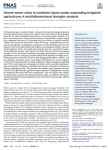Junquera V., Hormaza J.I., Rubenstein D.I., Levin S.A., Pérez I.V., Gavilán P.J. (2025). Severe water crisis in southern Spain under expanding irrigated agriculture: a multidimensional drought analysis. Proceedings of the National Academy of Sciences of the United States of America, 30/09/2025, vol. 122, n. 39, p. e2508055122.
https://doi.org/10.1073/pnas.2508055122
https://doi.org/10.1073/pnas.2508055122
| Titre : | Severe water crisis in southern Spain under expanding irrigated agriculture: a multidimensional drought analysis (2025) |
| Auteurs : | V. Junquera ; J.I. Hormaza ; D.I. Rubenstein ; S.A. Levin ; I.V. Pérez ; P.J. Gavilán |
| Type de document : | Article |
| Dans : | Proceedings of the National Academy of Sciences of the United States of America (vol. 122, n. 39, September 2025) |
| Article en page(s) : | p. e2508055122 |
| Langues : | Anglais |
| Catégories : |
Catégories principales 07 - ENVIRONNEMENT ; 7.3 - Eau. Gestion de l'EauThésaurus IAMM GESTION DES EAUX ; EAU D'IRRIGATION ; SECHERESSE ; EPUISEMENT DES RESSOURCES ; AGRICULTURE ; ESPAGNE |
| Résumé : | The Axarquía region in southern Spain, a hotspot of avocado and mango production in Europe, underwent an extreme water crisis in 2019–2024. Reservoir levels dropped below the 8% outlet threshold and groundwater in the main aquifer dropped to sea level in several locations, risking seawater intrusion. Socioeconomic impacts ranged from substantial crop losses to a potential long-term decline in regional economic viability. We examine the main drivers of this crisis using a coupled human and natural systems approach, combining an examination of water and land governance with analysis of time series (dam inflows and outflows, meteorological variables, reservoir, and groundwater levels) and spatial data (irrigated land use, groundwater bodies, water entitlement location, and volume). Our results show two severe meteorological droughts in close succession immediately preceding rapid declines in reservoir and groundwater reserves. Emergency measures delayed dam depletion but likely exacerbated groundwater extraction. Reservoir data disaggregating inflows, outflows, and uses (irrigation and urban) show an increasing trend in dam water use for irrigation in 2000–2022 associated with increasing irrigated area. Water management planning since 1998 reveals important inconsistencies within and between plans pointing to large uncertainties in freshwater availability and extraction and aquifer overdraft even during nondrought periods. The Axarquía case exhibits many symptoms of water crises faced by agriculturally significant regions globally. It highlights the necessity for integrated basin-scale land–water management, caps on irrigated area, flexible extraction quotas, real-time metering at all extraction points, and effective enforcement mechanisms, substantiating management lessons derived from major drought-affected regions worldwide. |
| Cote : | Réservé lecteur CIHEAM |
| URL / DOI : | https://doi.org/10.1073/pnas.2508055122 |







